Dry-Brined Turkey
This post may contain affiliate links. Read my full disclosure policy.
Discover the secret to a perfectly juicy and flavor-packed bird with this easy dry-brined turkey recipe—it’s a holiday game-changer!
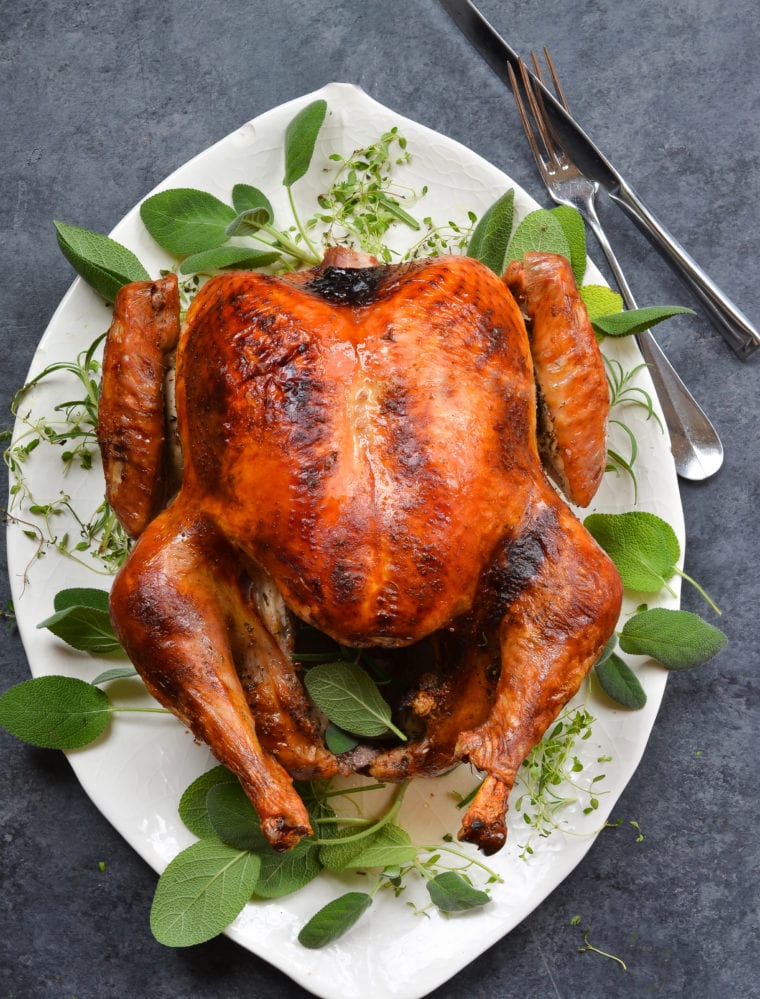
This fantastic dry-brined turkey, adapted from a Jeff Mauro recipe featured in Rachel Ray Magazine, was passed on to me by the talented food stylist Rebecca Jurkevich, who styled my second cookbook. What I particularly love about this recipe is its simplicity. You start by rubbing a mixture of salt and seasonings—the dry brine—onto the turkey’s skin, then let it rest in the fridge overnight. The salt not only thoroughly seasons the meat but also draws out the bird’s natural juices, creating a self-brine that the meat reabsorbs, guaranteeing a turkey that’s flavorful and juicy from the inside out. Plus, the rest in the fridge dries out the exterior of the bird, so when you cook it, you end up with the most beautifully crispy, golden-brown skin. Whether you’re a seasoned cook or a turkey first-timer, this dry-brined turkey recipe is a must-try for its ease and dependable results.
“My husband just declared this is the best turkey we’ve made in 40 years!!!! I concur!!”
What You’ll Need To Make A Dry-Brined Turkey
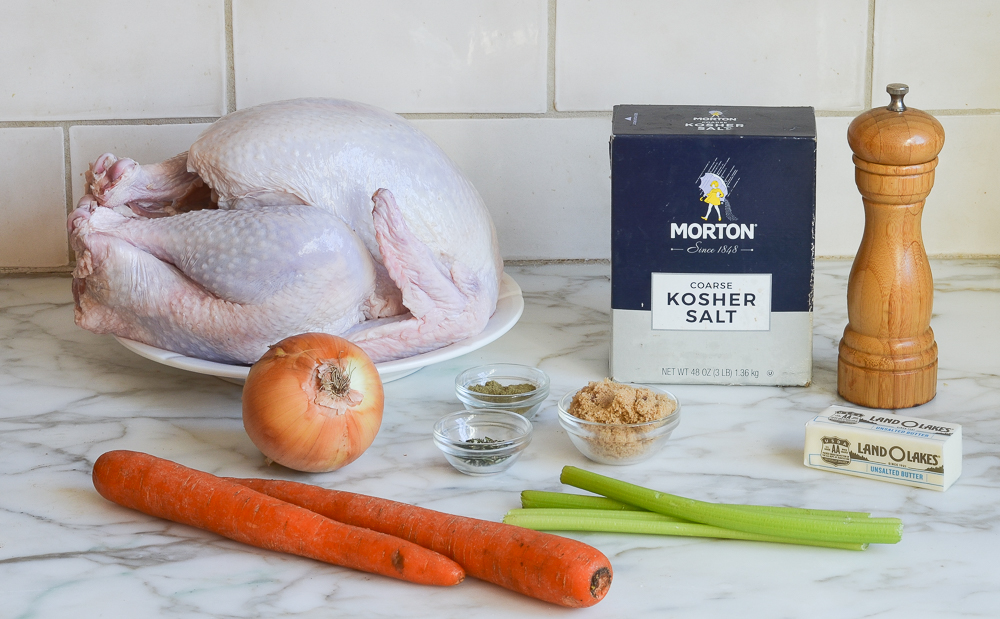
Step-by-Step Instructions
In a small bowl, mix the sugar, salt, thyme, sage, and pepper for the dry brine.
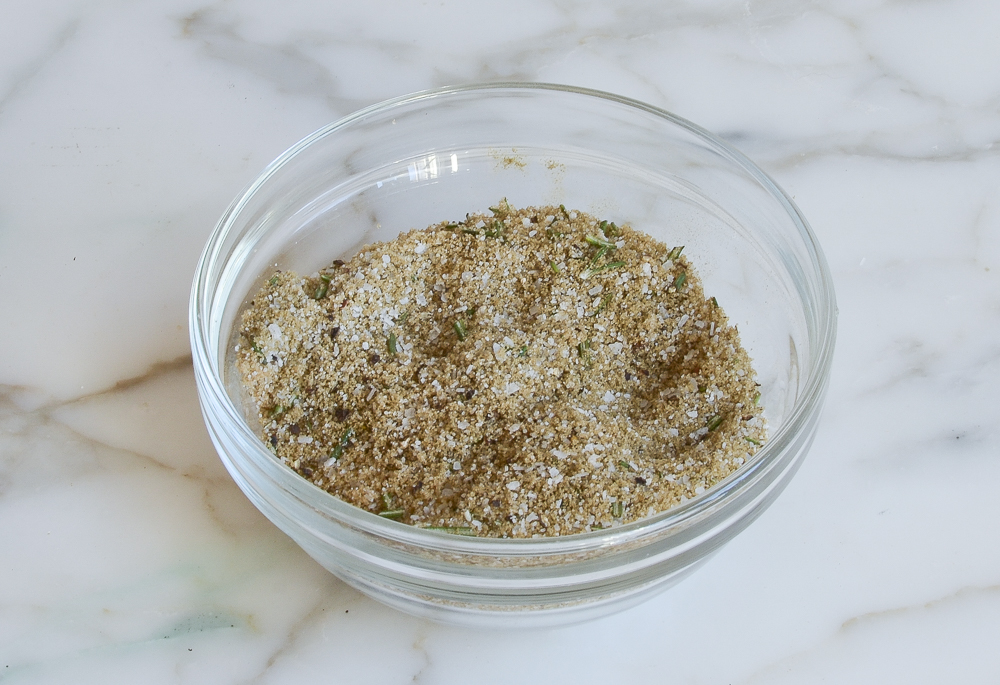
Place the turkey on the rack of a baking sheet. Rub and pat the dry brine all over the turkey, including inside the cavity. Refrigerate, uncovered, for at least 24 hours and up to 48 hours.
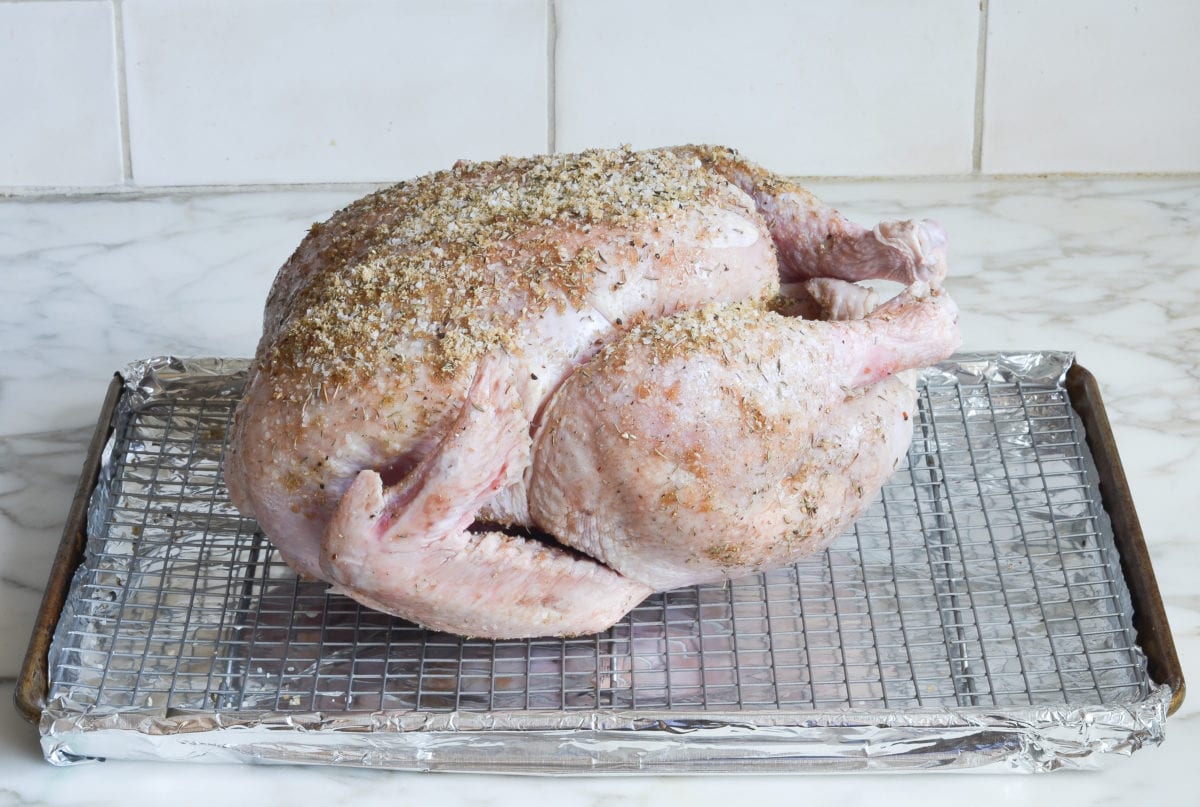
Using damp paper towels, brush the dry brine off the turkey.
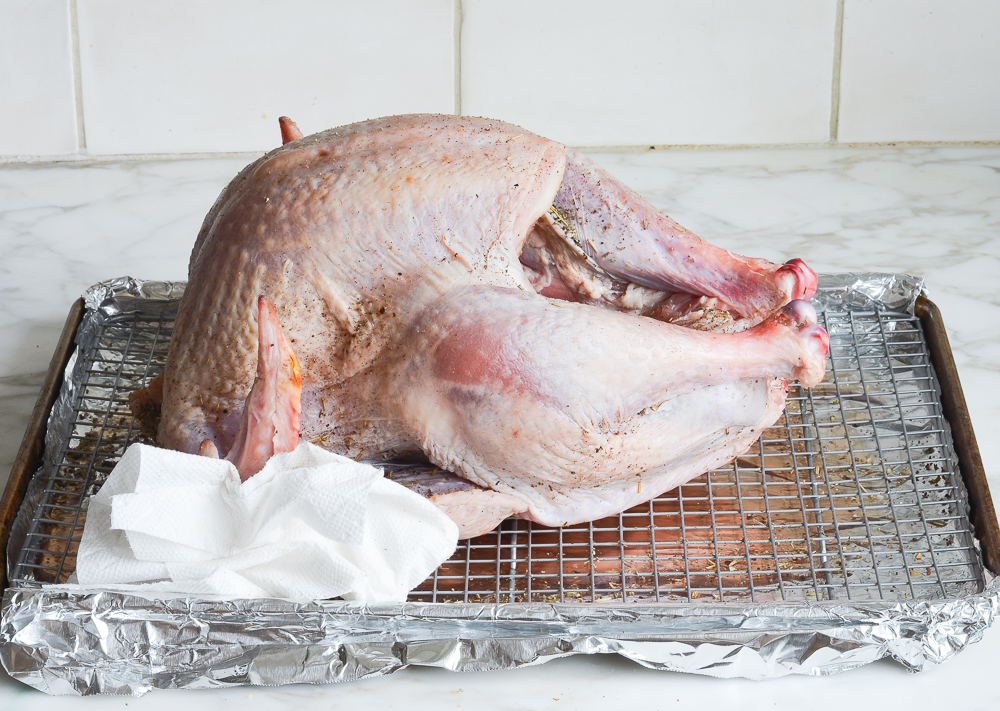
Scatter the onion, carrots, and celery in the bottom of a large roasting pan. Place a roasting rack inside the pan and place the turkey on the rack. Tuck the wings underneath the bird.
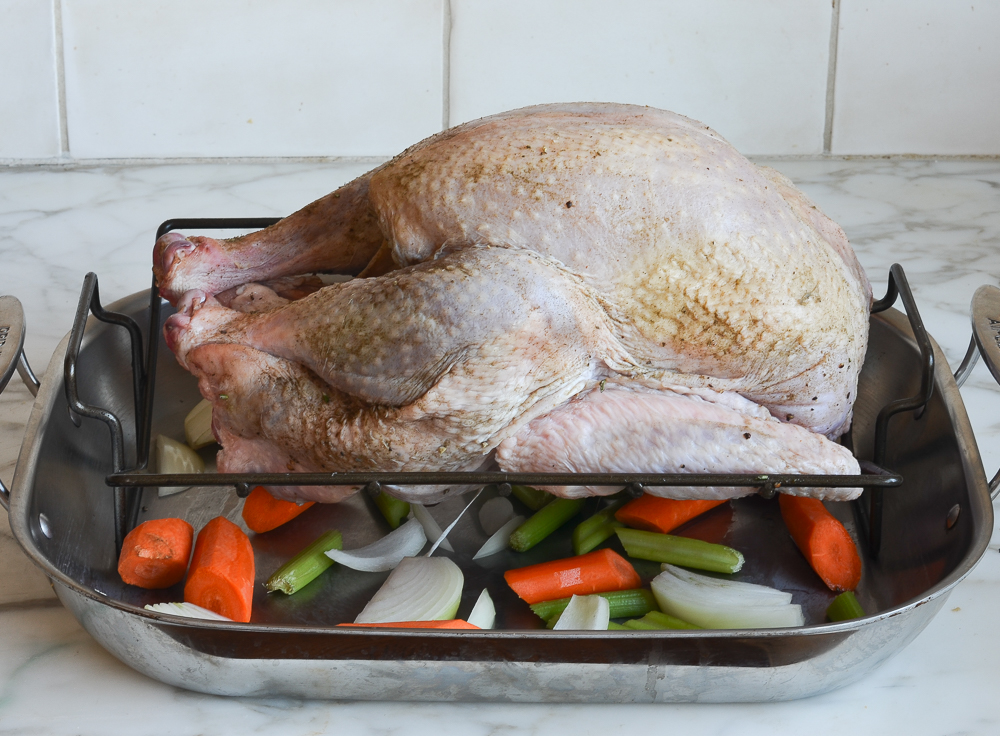
Using your hands, smear the butter all over the turkey.
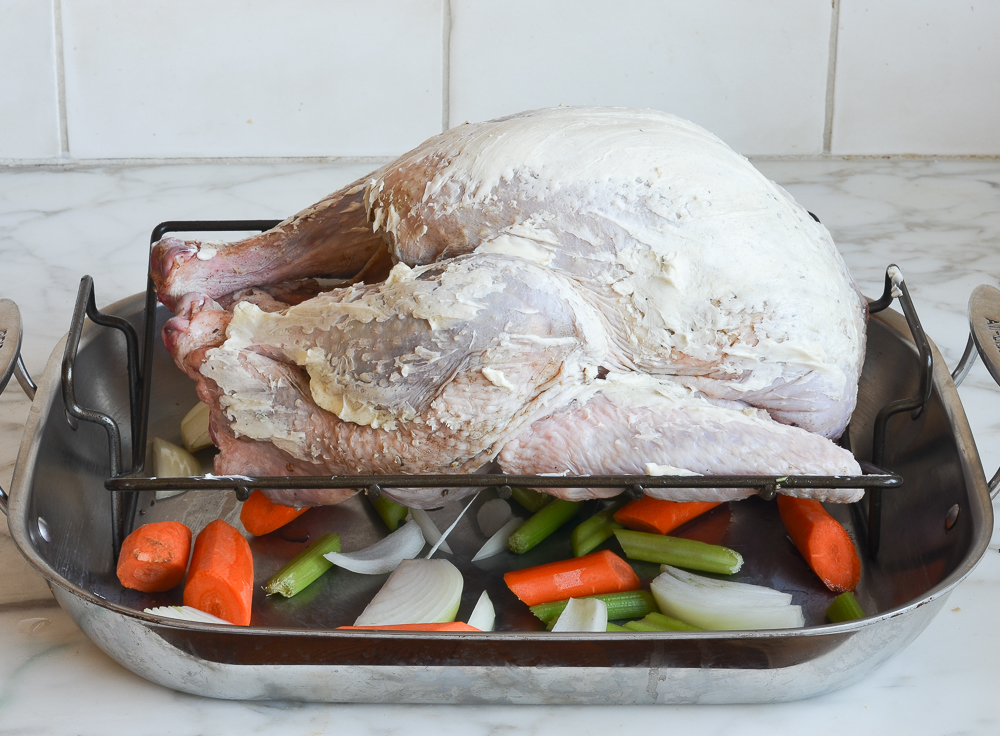
Roast the turkey until the skin is deep golden and an instant-read thermometer registers 165°F when inserted into the thickest part of the breast and the thigh, 1-3/4 to 2-1/2 hours. Check the turkey after 1-1/2 hours. If it’s getting too dark, cover it loosely with foil.
Note: The cooking time will depend on the size of your turkey. For best results, I recommend using a digital thermometer with a leave-in probe and remote monitor, like the one shown below. That way, you can monitor the temperature of the turkey without ever opening your oven.
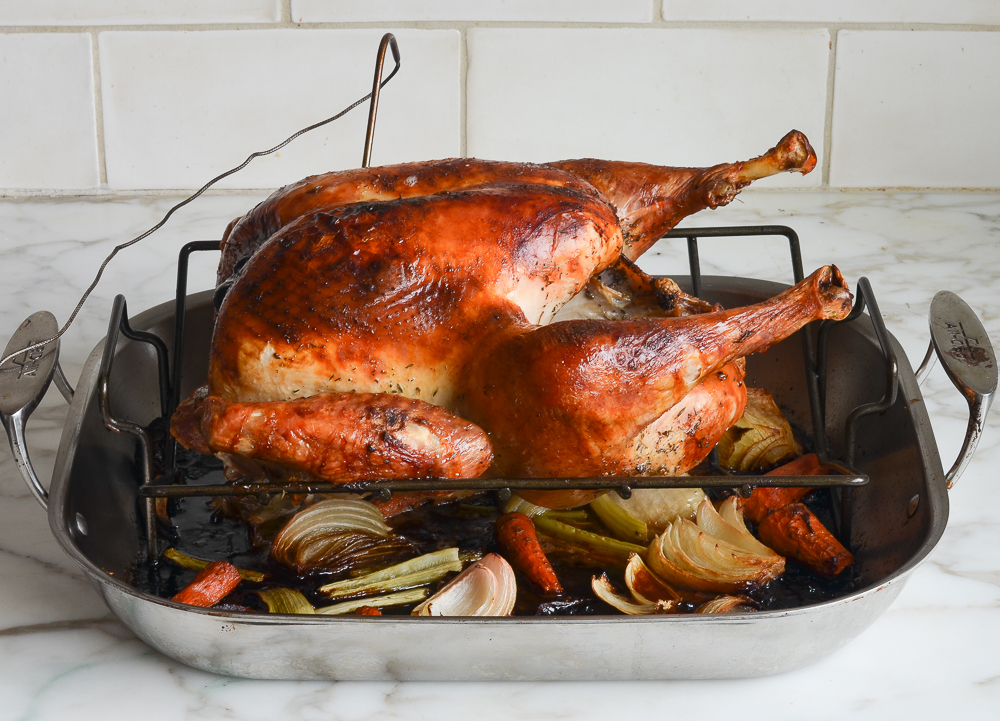
Using clean oven mitts (that you don’t mind getting dirty), carefully tilt the turkey so any juices from the cavity pour into the roasting pan. Transfer the turkey to a platter or cutting board. Tent with foil and let rest for 20 to 30 minutes. Remove the vegetables from the pan and discard (or if they aren’t too soft/brown, save them and arrange on the serving platter with the turkey). Reserve the drippings in the pan for the gravy. While the turkey rests, make the turkey gravy.
Carve the turkey and serve with the gravy on the side.
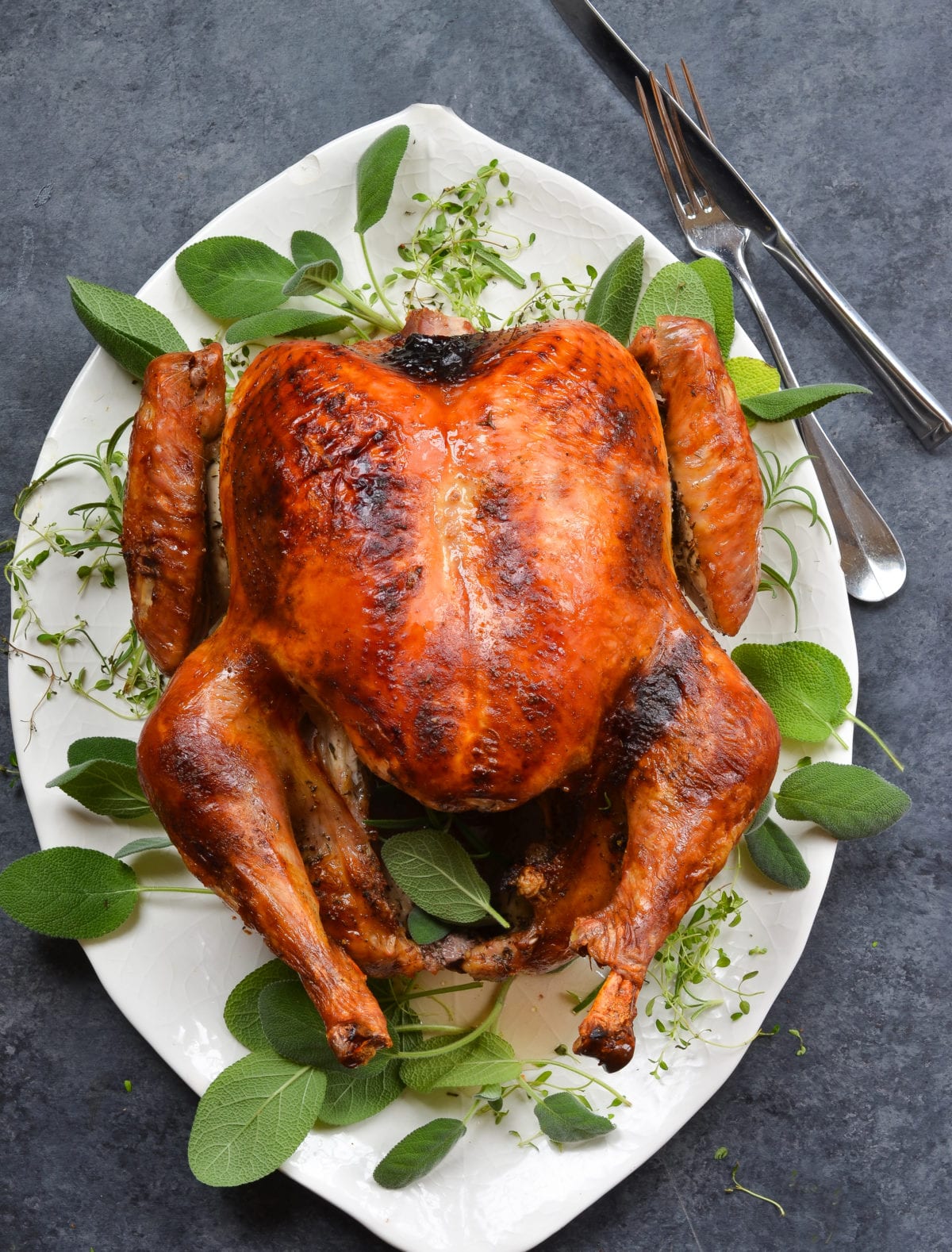
Frequently Asked Questions
A: Dry brining involves rubbing salt, herbs, and spices onto the turkey skin and letting it sit in the fridge overnight (or longer). Wet brining, in contrast, requires soaking the turkey in a seasoned saltwater solution, often necessitating a large cooler or bag and can be quite cumbersome. While both methods enhance flavor and juiciness, dry brining is much simpler and produces crisper skin.
A: The recommended time for dry brining is at least 1 day and up to 3 days. The longer you allow the turkey to brine, the more flavorful and moist it will be. However, even just 24 hours of brining can make a significant difference. You can adjust the salt quantity based on the brining duration to avoid over-salting.
A: If your turkey has been pre-injected with a solution (as is common with many store-bought turkeys), you can still use this dry-brined recipe effectively. These types of turkeys still benefit from additional seasoning for enhanced flavor. However, since they already contain some salt, you should reduce the amount of salt used in the dry brine by half to prevent the turkey from becoming overly salty.
You May Also Like
- 24 Best Thanksgiving Side Dishes
- 18 Thanksgiving Desserts Worth Saving Room For
- Rolled Turkey Breast with Sausage & Herb Stuffing
- Fresh Cranberry Sauce
- Creamy Make-Ahead Mashed Potatoes
- Easy Sausage & Herb Stuffing
Dry-Brined Turkey
Discover the secret to a perfectly juicy and flavor-packed bird with this easy dry-brined turkey recipe—it’s a holiday game-changer!
Ingredients
- 1 (12 to 14-pound) turkey, patted dry (see note)
- ¼ cup (packed) light brown sugar
- 3 tablespoons Morton kosher salt (or ¼ cup Diamond kosher salt)
- 2 teaspoons dried thyme
- 2 teaspoons dried sage leaves or ground sage
- 1 teaspoon freshly ground black pepper
- 6 tablespoons unsalted butter, at room temperature
- 1 large yellow onion, cut into wedges
- 2 carrots, cut into 2-inch pieces
- 2 stalks celery, cut into 2-inch pieces
Instructions
- Line a rimmed baking sheet with aluminum foil for easy clean up, and set an oven rack on top.
- Remove and discard the truss that holds turkey legs together (if the legs are held together with turkey skin, cut the skin to release them). Trim off and discard any excess fat in the neck or body cavity. Remove giblets and neck; discard or save for stock. Rinse the turkey inside and out with warm water. Pat dry with paper towels.
- In a small bowl, mix the sugar, salt, thyme, sage, and pepper for the dry brine. Place the turkey on the rack of the prepared baking sheet. Rub and pat the dry brine all over the turkey, including inside the cavity. Refrigerate, uncovered, for at least 24 hours and up to 48 hours. (For food safety, ensure the turkey remains in the refrigerator at 40°F or lower during the entire brining period. If brining for longer than 24 hours, you can cover the turkey loosely with plastic wrap for the first part of the brining process and then uncover it for the final 24 hours to allow the skin to dry.)
- Preheat the oven to 375°F and set an oven rack in the lower third of the oven. Using damp paper towels, brush the dry brine off the turkey.
- Scatter the onion, carrots, and celery in the bottom of a large roasting pan. Place a roasting rack inside the pan and place the turkey on the rack. Tuck the wings underneath the bird. Using your hands, smear the butter all over the turkey.
- Roast the turkey until the skin is deep golden and a leave-in or instant-read thermometer registers 165°F when inserted into the thickest part of the breast and the thigh, 1¾ to 2½ hours (see note). Check the turkey after 1½ hours. If the skin is getting too browned, cover it loosely with foil.
- Using clean oven mitts (that you don't mind getting dirty), carefully tilt the turkey so any juices from the cavity pour into the roasting pan. Transfer the turkey to a platter or cutting board. Tent with foil and let rest for 20 to 30 minutes. Remove the vegetables from the pan and discard (or if they aren't too soft/brown, save them and arrange on the serving platter with the turkey). Reserve the drippings in the pan for the gravy.
- While the turkey rests, make the gravy.
- Carve the turkey and serve with the gravy on the side.
- Make-Ahead Instructions: If you don't mind losing the crispy skin, the turkey can be roasted and carved ahead of time. Pour a thin layer of the gravy into an ovenproof serving dish. Arrange the carved turkey nicely on top of the gravy; cover tightly with plastic wrap and refrigerate for up to two days. Refrigerate the remaining gravy in a separate container. To reheat: remove the plastic wrap and cover the platter with aluminum foil. Place in a 325°F-oven for 20 to 30 minutes, until the turkey is hot. Reheat the gravy in the microwave or on the stovetop.
- Note on Selecting Your Turkey: For the best results with this dry-brining method, look for a turkey that is not kosher, injected, or labeled as "self-basting." These types of turkeys have already been treated with salt or a brining solution. However, if you can only find a kosher, injected, or self-basting turkey, you can still use this recipe, as these birds do still benefit from additional seasoning. Just halve the amount of salt in the dry brine to avoid over-salting.
- Note: I've given a range for the cooking time, which will depend on the size of your turkey. For best results, I recommend using a digital thermometer with a leave-in probe and remote monitor (like this one). That way, you can monitor the temperature of the turkey without ever opening your oven.
Pair with
Nutrition Information
Powered by ![]()
- Per serving (8 servings)
- Calories: 1,075
- Fat: 47 g
- Saturated fat: 15 g
- Carbohydrates: 6 g
- Sugar: 5 g
- Fiber: 0 g
- Protein: 147 g
- Sodium: 1,619 mg
- Cholesterol: 513 mg
This website is written and produced for informational purposes only. I am not a certified nutritionist and the nutritional data on this site has not been evaluated or approved by a nutritionist or the Food and Drug Administration. Nutritional information is offered as a courtesy and should not be construed as a guarantee. The data is calculated through an online nutritional calculator, Edamam.com. Although I do my best to provide accurate nutritional information, these figures should be considered estimates only. Varying factors such as product types or brands purchased, natural fluctuations in fresh produce, and the way ingredients are processed change the effective nutritional information in any given recipe. Furthermore, different online calculators provide different results depending on their own nutrition fact sources and algorithms. To obtain the most accurate nutritional information in a given recipe, you should calculate the nutritional information with the actual ingredients used in your recipe, using your preferred nutrition calculator.
Gluten-Free Adaptable Note
To the best of my knowledge, all of the ingredients used in this recipe are gluten-free or widely available in gluten-free versions. There is hidden gluten in many foods; if you're following a gluten-free diet or cooking for someone with gluten allergies, always read the labels of your ingredients to verify that they are gluten-free.

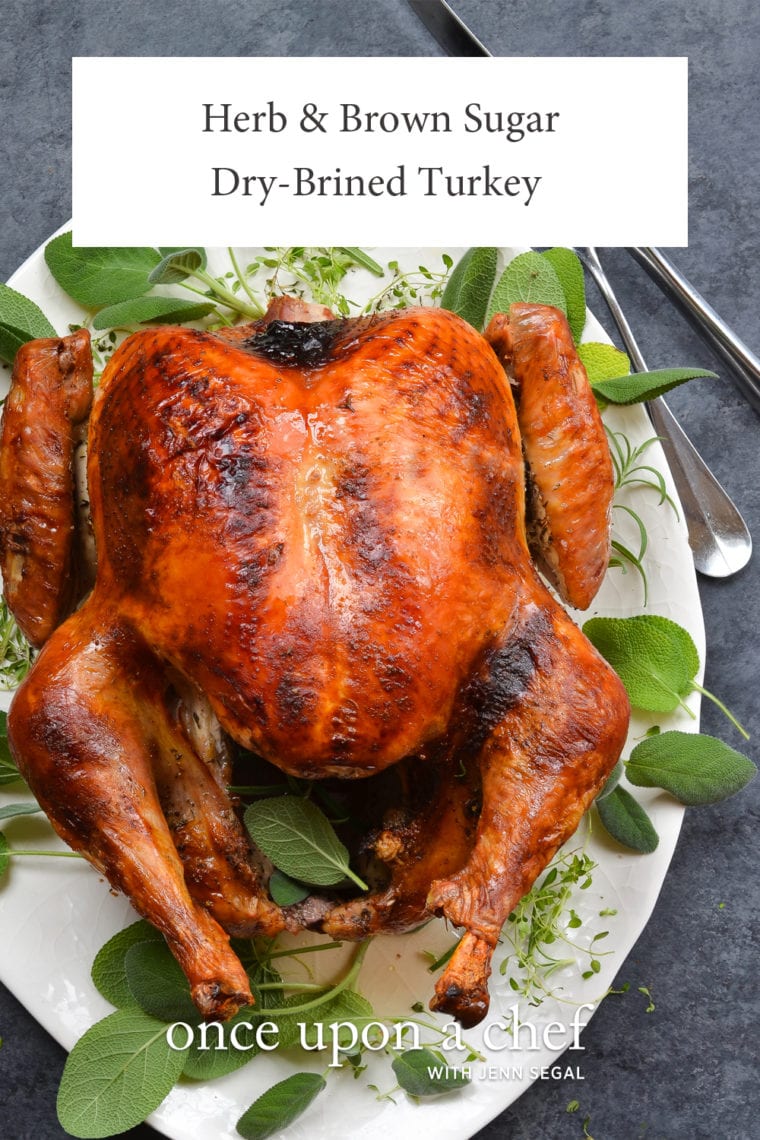
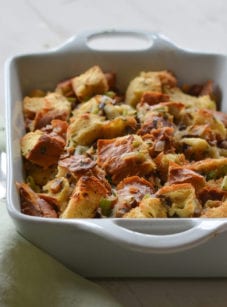
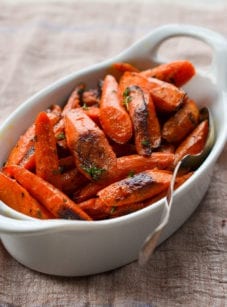
I just put the brine all over my turkey after drying it. But as I was putting it on my turkey it began to get very moist because I had just rinsed it and it is thawing. Is it ok if it’s wet with the brine on it?
Thank you
Hi Amy, it should be fine. 🙂
So I shouldn’t add to it in case some of it washed off with all the moisture?
Thank you
Hi Amy, I think it’s fine as is, but it won’t hurt if you want to add a bit more to the top as insurance.
Ok I have about 8 hours before I cook it. Do you think it will make a difference? Also will it make it more salty?
Thank you!
Hi Amy, I think the difference will be minimal but it will make it more salty.
I just have a regular digital thermometer. Do I just keep opening the oven to check the temperature? We have 13lb. turkey.
Hi Amy, I would just pull the turkey out at 1-3/4 hours and check the temp. If it needs more time, I’d give it an extra 10 to 15 minutes and check again. Hope you enjoy!
Hi Jenn, I love your recipes. Could I do a dry brine and then spatchcock the bird or deconstruct? We are trying to cook two 12 pound turkeys at the same time but we only have one oven. Thanks!
Sure, that will work.
Hello! Love your recipes and have been using them for years. If the thermometer touches the bone won’t it give an inaccurate reading? I always was taught to avoid the bone when checking temp?
Thank you!
Hi Harper, so glad you like the recipes! Thanks for pointing that out and sorry for any confusion — it was a typo and I’ve just updated it. 🙂
It’s just my wife and I for Thanksgiving this year. Keeping that in mind, we’ve decided to roast a chicken for just the two of us. Any tips on scaling back the brine ingredients for a chicken?
Thanks!
Hi Mike, You could definitely use the brine on chicken; just adjust the quantities according to the weight of the bird. Happy Thanksgiving!
Hello I’ve never had any luck baking a turkey. Always dry! ): I’m thinking about using this recipe. However I don’t know if my turkey will be thawed out enough to brine in time
Hi Amy, You can actually start the dry-brining process while your turkey thaws.
So if its still partially frozen I can put the brine on?
Thank you
Yep 👍
Thank you so much for responding so quickly. A few last questions, when you wipe the brine off the outside do you try to get it out of the inside also? Will 24 hours be enough time to brine? Is the brining method better than the turkey in the bag technique?
Thank you very much!
Hi Amy, No need to wipe the inside of the bird and, yes, 24 hrs is long enough to brine. I do think the method is better than the turkey in the bag. 🙂
I am cooking an 8 lb. bone in turkey breast. I think I would use half the amount of the rub, but am curious as to how long to roast it, and at 375 or 350?
Hi Ellen, That sounds correct re. the rub. I’m guessing it would take 1-1/4 to 1-1/2 hrs at 375, but definitely check with a thermometer.
Thanks for your quick reply!
Add us to the list of those who bought the Big Easy this year because of you 😉
Maybe a silly question but…can I use this dry brine in the Big Easy? I assume I skip the butter and the vegetables but can I follow the directions otherwise, including the brown sugar?
Thanks and Happy Thanksgiving!
Hi Rebecca! I hope you enjoy the Big Easy. 🙂 You can use the brine (minus the butter and veggies) but omit the brown sugar – it may burn in the fryer. I would brush the turkey with some oil before cooking. Happy Thanksgiving!
That Big Easy is the best! Been doing our turkey that way for quite a few years now. 🙂 Thanks for the info regarding how to brine the turkey for use with that. Very helpful.
Have a blessed Thanksgiving.
This rub was so delicious on our turkey! I cooked the turkey in our convection oven which browned up the skin and locked in the juices. I used 2 temperature probes, one on each side of the turkey, and rotated the turkey when I noticed the temperature was getting too uneven. Everyone kept going on about the amazing flavor and so tender and juicy. Thank you for sharing this recipe.
For a 28 pound turkey do I double the brine and bake 325? Thank you
Hi Marie, Yes that’s what I would do; the cook time will be much longer.
Hi Jenn,
I would like to try this recipe for the dry-brined turkey instead of the high-heat method, but my turkey is a frozen injected one. Would I need to eliminate the salt?
Hi Leigh, If you eliminate the salt, the turkey won’t technically “brine.” I think you could get away with using it if you reduce the salt by half.